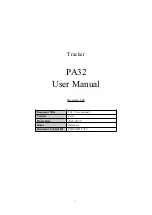
Teletrac, Inc. - Prism TM Information and Installation Guide
44
1622-0300
B1
3/18/04
Step 3: Getting Perfect Timing
If measuring the travel time of a radio signal is the key to GPS, then our stop watches had better
be darn good, because if their timing is off by just a thousandth of a second, at the speed of light,
that translates into almost 200 miles of error!
On the satellite side, timing is almost perfect because they have incredibly precise atomic clocks
on board.
But what about our receivers here on the ground?
Remember that both the satellite and the receiver need to be able to precisely synchronize their
pseudo-random codes to make the system work.
If our receivers needed atomic clocks (which cost upwards of $50K to $100K) GPS would be a
lame duck technology. Nobody could afford it.
Luckily the designers of GPS came up with a brilliant little trick that lets us get by with much less
accurate clocks in our receivers. This trick is one of the key elements of GPS and, as an added
side benefit, it means that every GPS receiver is essentially an atomic-accuracy clock.
The secret to perfect timing is to make an extra satellite measurement.
That's right, if three perfect measurements can locate a point in 3-dimensional space, then four
imperfect measurements can do the same thing.
E
XTRA
M
EASUREMENT
C
URES
T
IMING
O
FFSET
If everything were perfect (i.e. if our receiver's clocks were perfect) then all of our satellite ranges
would intersect at a single point (which is our position). But with imperfect clocks, a fourth
measurement, done as a cross-check, will NOT intersect with the first three.
So the receiver's computer says "Uh-oh! There is a discrepancy in my measurements. I must not
be perfectly synced with universal time."
Since any offset from universal time will affect all of our measurements, the receiver looks for a
single correction factor that it can subtract from all its timing measurements that would cause
them all to intersect at a single point.
That correction brings the receiver's clock back into sync with universal time, and bingo! - you've
got atomic accuracy time right in the palm of your hand.
Once it has that correction it applies to all the rest of its measurements and now we've got
precise positioning.
One consequence of this principle is that any decent GPS receiver will need to have at least four
channels so that it can make the four measurements simultaneously.
O.K, with the pseudo-random code as a rock solid timing sync pulse, and this extra measurement
trick to get us perfectly synced to universal time, we have got everything we need to measure our
distance to a satellite in space.
But for the triangulation to work we not only need to know distance, we also need to know exactly
where the satellites are.
Summary of Contents for Prism TM
Page 2: ...Teletrac Inc Prism TM Information and Installation Guide 2 1622 0300 B1 3 18 04...
Page 4: ...Teletrac Inc Prism TM Information and Installation Guide 4 1622 0300 B1 3 18 04...
Page 6: ...Teletrac Inc Prism TM Information and Installation Guide 6 1622 0300 B1 3 18 04...
Page 18: ...Teletrac Inc Prism TM Information and Installation Guide 18 1622 0300 B1 3 18 04...
Page 20: ...Teletrac Inc Prism TM Information and Installation Guide 20 1622 0300 B1 3 18 04...
Page 27: ...Teletrac Inc Prism TM Information and Installation Guide 1622 0300 B1 3 18 04 27...
Page 35: ...Teletrac Inc Prism TM Information and Installation Guide 1622 0300 B1 3 18 04 35...
Page 39: ...Teletrac Inc Prism TM Information and Installation Guide 1622 0300 B1 3 18 04 39...
Page 49: ...Teletrac Inc Prism TM Information and Installation Guide 1622 0300 B1 3 18 04 49...
Page 53: ...Teletrac Inc Prism TM Information and Installation Guide 1622 0300 B1 3 18 04 53...
Page 59: ...Teletrac Inc Prism TM Information and Installation Guide 1622 0300 B1 3 18 04 59...
Page 61: ...Teletrac Inc Prism TM Information and Installation Guide 1622 0300 B1 3 18 04 61...















































